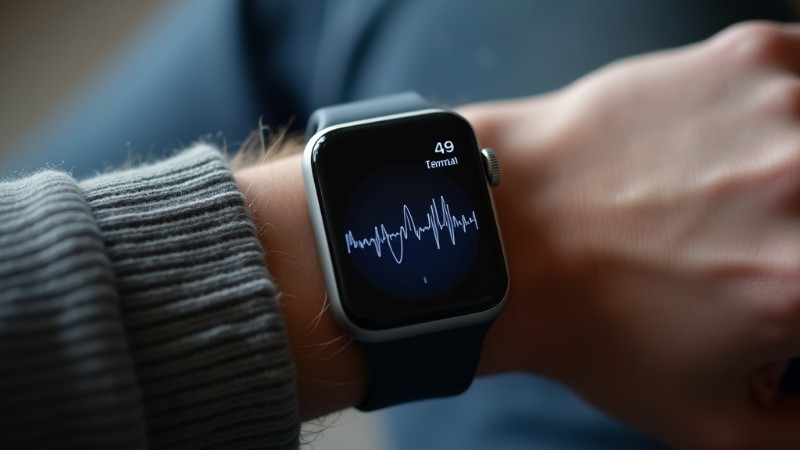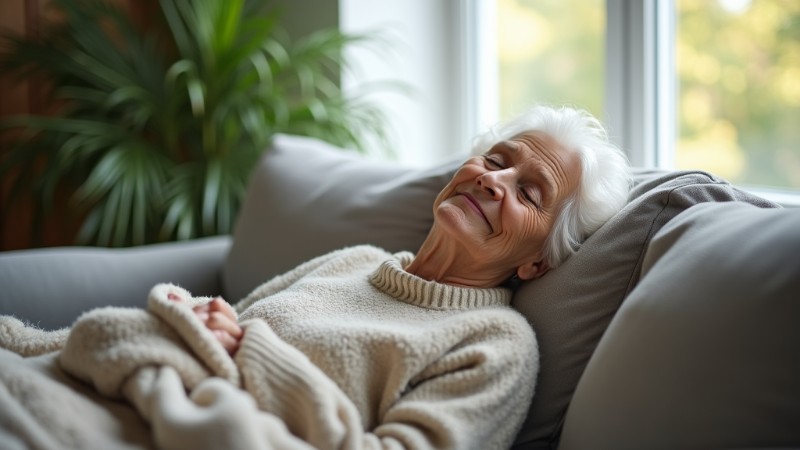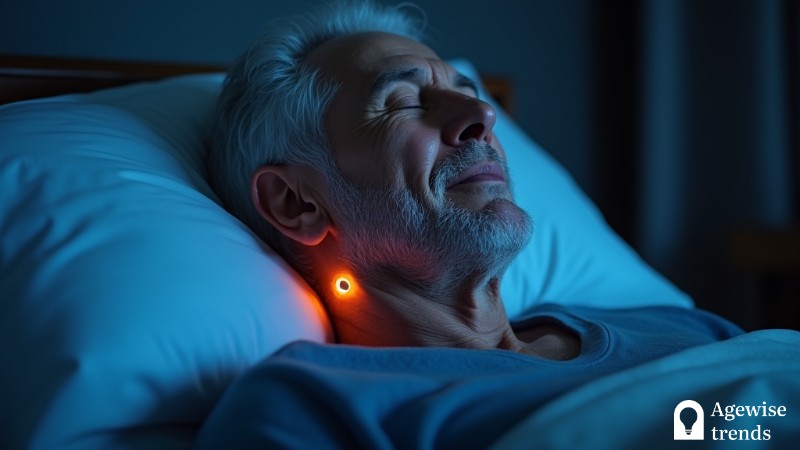Sleep patterns and health often shift with aging, impacting the quality of sleep and overall wellness.
Many seniors experience disrupted sleep due to factors such as sleep apnea—a common yet often undiagnosed condition affecting millions. Technology is now making it easier to monitor and address these changes.
With advancements from companies like Apple and Samsung, smartwatches help detect sleep disorders and promote better sleep hygiene, which is essential for restful nights as we navigate sleeping and aging.
Sleep apnea, a disorder that disrupts breathing during sleep, often goes unnoticed by those who experience it.
These breathing interruptions cause brief wake-ups throughout the night, which diminish sleep quality and lead to fatigue and other health issues. Untreated, sleep apnea can heighten the risk of cardiovascular disease, Type 2 diabetes, and cognitive decline.
Experts estimate that up to 25 million Americans may suffer from sleep apnea, many unknowingly. Early detection can make a significant difference, allowing for timely treatment and adjustments that support improved health.
Key Takeaways
Smartwatches like Apple and Samsung’s Galaxy Watch can detect sleep apnea in seniors by monitoring vital signs during sleep, providing valuable insights into sleep quality.
- Early detection of sleep apnea through smartwatches can make a significant difference in reducing risks associated with untreated cases, such as heart disease and mental decline.
- Wearable technology provides an accessible way to detect sleep apnea, helping users take control of their health by making informed decisions based on real data.
- Smartwatches from brands like Apple and Samsung offer features that cater to different needs, such as tracking blood oxygen levels or monitoring breathing disturbances.
How smartwatches detect sleep apnea
Smartwatches like the Samsung Galaxy Watch and the Apple Watch use advanced sensors to monitor vital signs during sleep, which can signal potential sleep apnea.
These sensors measure blood oxygen levels, breathing patterns, and heart rate—all factors that help indicate whether someone may be experiencing irregular breathing while sleeping.
Samsung’s Galaxy Watch requires two nights of sleep data over ten days to identify signs of moderate to severe sleep apnea.
By tracking oxygen levels and breathing interruptions, the watch provides valuable insights into sleep quality, allowing users to take appropriate action if abnormalities are detected.
On the other hand, Apple’s system, available on newer Apple Watches, uses machine learning to detect breathing patterns that could indicate sleep apnea.
Sleep apnea detection for seniors
Detecting sleep apnea in its early stages can help seniors maintain their health by reducing risks associated with untreated sleep disorders.
Identifying potential issues allows for better management options, such as consulting a doctor, exploring CPAP therapy, or incorporating relaxation techniques and healthy sleep hygiene practices.
Through wearable technology, both Apple and Samsung are making it simpler for seniors to identify potential sleep apnea issues, offering the chance for proactive steps to be taken to improve overall well-being.
This trend in wearable technology is a valuable addition for seniors who may want to monitor their health but prefer simple, non-invasive tools.
Apple vs Samsung’s sleep apnea features
While both Apple and Samsung offer sleep apnea detection features, each brand has its unique approach.
Samsung’s Galaxy Watch focuses primarily on moderate to severe obstructive sleep apnea, tracking blood oxygen levels during sleep for a clear understanding of breathing irregularities.
Apple, however, takes a broader approach by monitoring breathing disturbances and using advanced machine-learning algorithms to identify potential signs of sleep apnea.
Apple Watch sleep apnea detection gets FDA approval https://t.co/xUKpYFEnXu
— TechCrunch (@TechCrunch) September 16, 2024
Users can view Apple’s assessments on iPhone or iPad through the Health app, which offers consistent tracking of respiratory health.
These differences mean that each smartwatch can cater to slightly different needs.
Samsung’s watch may appeal to those concerned with detecting more serious cases of sleep apnea, while Apple’s ongoing monitoring may be beneficial for those who prefer consistent tracking of their respiratory health.
Benefits of early detection
For seniors, early detection of sleep apnea can be life-changing. When caught early, sleep apnea can be managed more effectively, reducing risks associated with untreated cases, such as heart disease and mental decline.
Wearable technology provides an accessible way to detect this condition, helping users to take control of their health by making informed decisions based on real data.
By using a smartwatch with sleep apnea detection, seniors can better understand their nighttime breathing patterns.
This data can guide decisions on when to seek medical advice or explore lifestyle changes to enhance sleep quality.
Knowing the patterns in their sleep can also empower seniors to practice better sleep hygiene and incorporate relaxation techniques to foster restful sleep.
Incorporating these habits into your daily routine can support better sleep, particularly if you experience sleep disorders or simply want to improve the quality of your rest.
Wearable technology in managing sleep health
As wearable technology continues to evolve, its role in monitoring sleep and identifying disorders grows more important.
Smartwatches from brands like Apple and Samsung can detect signs of sleep apnea, allowing seniors to stay informed about their sleep health. With this information readily available, users can address potential issues early and seek professional help if necessary.
For instance, the Health app on Apple devices provides a detailed report of nighttime respiration patterns.
Each month, it checks for irregularities and alerts the user if signs of sleep apnea are detected.
This feature also includes educational content and a PDF report summarizing three months of data, which can be shared with a healthcare provider.
Practical tools in smartwatches for tracking and understanding sleep health empower seniors to prioritize well-being and take charge of their sleep.
Addressing sleep apnea without a doctor’s visit
Many people are unaware they have sleep apnea, as symptoms may go unnoticed for years. For those who suspect they may have sleep apnea but are hesitant to visit a doctor right away, home evaluation options can be a helpful first step.
Several companies offer home sleep tests that allow users to check for sleep apnea from the comfort of their own beds.
Additionally, trying CPAP therapy at home can provide an initial sense of whether treatment might be beneficial.
A CPAP machine gently blows air into the airway to keep it open during sleep, significantly improving sleep quality for those with sleep apnea.
Consulting a healthcare provider about these options can provide insight into which approach may work best.
Worldwide sleep apnea detection
Apple’s sleep apnea detection feature, recently launched in Canada, reflects the growing interest in using technology for health monitoring on a global scale.
Available in over 150 regions, this feature allows people around the world to monitor their nighttime breathing patterns and receive alerts if irregularities are detected.
Timely insights from smartwatches guide users toward better health outcomes and facilitate discussions with healthcare professionals.
The future of sleep health monitoring
As technology advances, smartwatches are expected to become even more capable of detecting and managing sleep apnea.
Innovations in sensors and machine learning algorithms are anticipated to enhance the accuracy of sleep apnea detection, making it an increasingly reliable tool for health monitoring.
With these advances, wearable devices will likely provide even more personalized data, helping seniors make informed choices about their health.
By offering accessible ways to monitor sleep, these devices could transform how people approach aging and health management, enabling them to take active steps to maintain quality of life.















